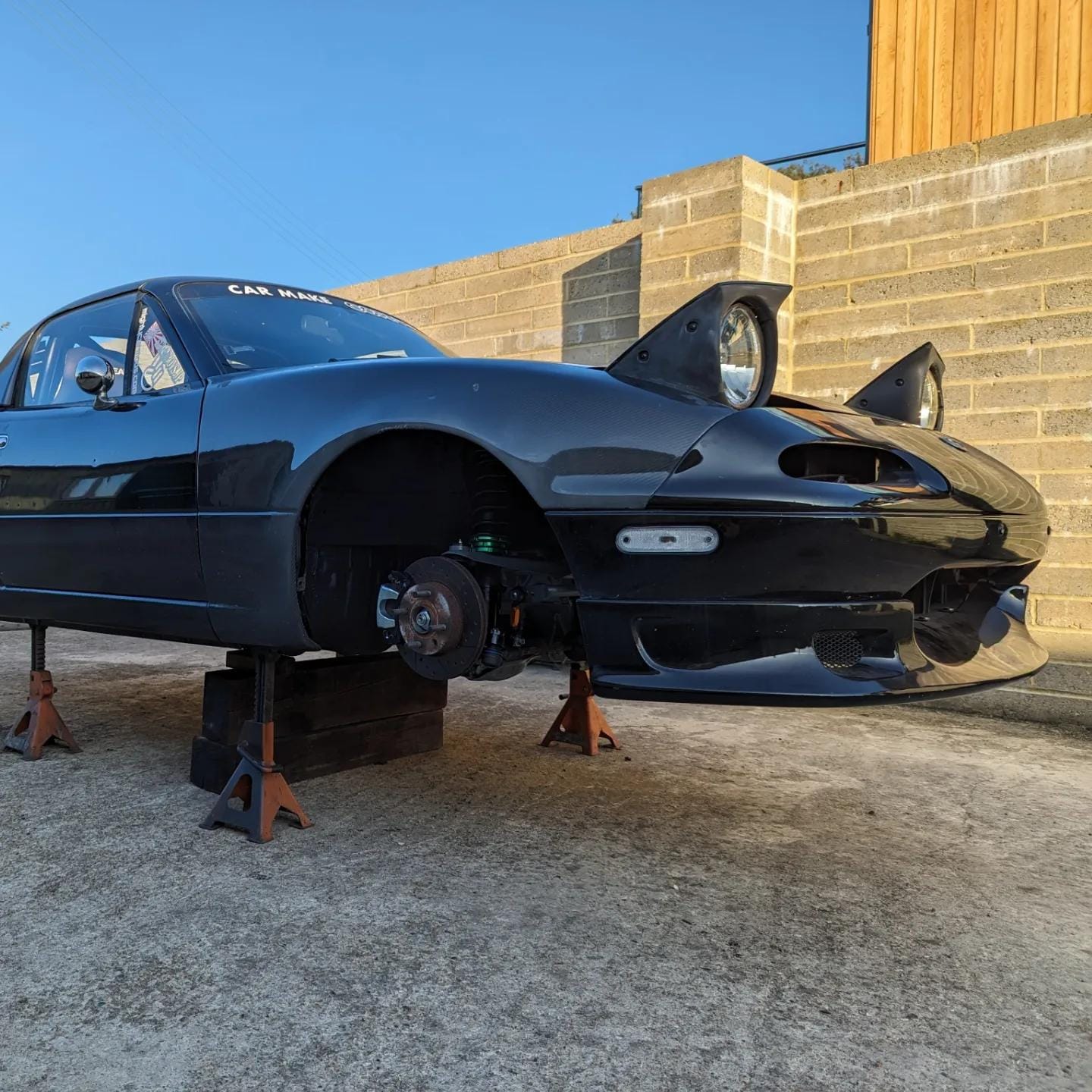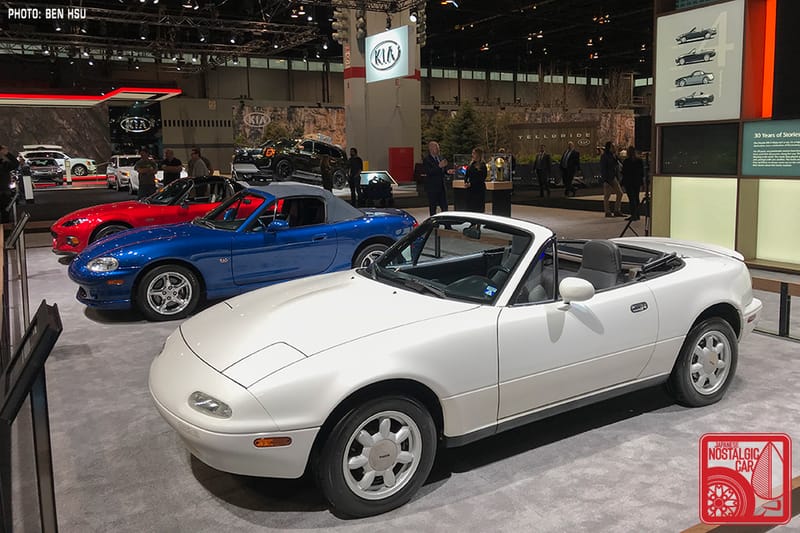When to Overhaul Your Miata's Suspension
worn bushings, leaky shocks, and aging components can dull that feel fast. If your ride feels sloppy or bouncy, it’s time for a suspension refresh. This guide covers what to replace and how to bring back that precise, playful MX-5 driving experience you fell in love with.

There’s something undeniably special about a Mazda MX-5 Miata. Whether you’re cruising around town with the top down or hitting the curvy backroads, the Miata’s lightweight chassis and balanced layout make it feel like an extension of yourself. But over time, even the best-balanced cars need a refresh, especially if your suspension is starting to feel sloppy or bouncy. Below, we’ll dive into when and why you should give your Miata’s suspension a proper overhaul, what parts to consider replacing, and how to ensure everything comes together for that signature MX-5 driving experience.
When your Miata’s suspension is in top shape, every corner feels precise, every bump is absorbed neatly, and you retain that playful, engaging drive. But as rubber bushings deteriorate, shocks start leaking, or control arms develop a little rust, your once laser-sharp Miata can begin to feel more like a bouncy old hatchback. Routine checks (and eventually a full overhaul) will help you keep the ride crisp and confidence-inspiring.
Signs It’s Time for a Suspension Overhaul
Suspension wear can creep up on you gradually, so it’s good to keep an eye on (and an ear out for) certain telltale signs. If you notice the car bobbing excessively after going over bumps, or continuing to “float” instead of settling, your shocks or struts might be on their last legs. Similarly, if your Miata’s steering has turned unpredictable, or if you hear clunking and squeaking over bumpy roads, there’s a good chance the bushings or ball joints need attention.
Another red flag is seeing visible fluid leakage on the shock body itself. That’s a clear indicator that internal seals are failing and your dampers need replacing. And if you ever spot uneven ride height (one side of the car sitting noticeably lower than the other) or alignment issues that just won’t dial in, you could be dealing with a bent component, worn spring, or hidden rust. Sometimes, you might not hear or feel anything dramatically wrong, but if your Miata is getting old or has racked up plenty of miles, it’s worth considering that rubber bushings degrade with time and mileage, even if they aren’t making noise yet.
Typical Lifespans of Key Components
No one can put an exact expiration date on a suspension part, but there are general mileage ranges that give you a ballpark. Shocks and struts usually last somewhere between 50,000 and 100,000 miles, though sporty driving and lowering springs can shorten that range. Control arms and their built-in ball joints might survive from 70,000 up to 150,000 miles. Rubber bushings can fail sooner if subjected to extreme temperatures, harsh roads, or spirited driving.
Many Miata owners reach a tipping point somewhere around the 100,000-mile mark, realizing that replacing everything at once, shocks, bushings, ball joints, and more, can be cheaper and more effective in the long run than fighting small issues one at a time.
Full Overhaul vs. Partial Replacement
A full-blown overhaul is usually the best choice if multiple components are already on their way out. If your shocks, bushings, and ball joints are all showing wear, it might be more budget-friendly (and less of a headache) to handle everything in one go. This is especially true if you’re driving hard or tracking the car, by the time you notice one part failing, there’s a decent chance something else is also close to the end of its life.
On the other hand, if your Miata is in pretty good shape overall and only one shock is leaking or just one control arm got bent from a pothole, a partial replacement might do the trick. Budget constraints can play a major role here as well. Sometimes you just need to fix the most pressing issues right away and save the complete overhaul for later.
Core Components to Address
When it comes to refreshing your Miata’s suspension, you’ll likely focus on a few key areas. First up are the shocks (or coilovers) and springs. You can go with OEM-style replacements for a close-to-stock ride, or opt for performance coilovers if you want to adjust the car’s ride height and damping for autocross or track events. Pay close attention to spring rates, stiffer springs can reduce body roll but might make the ride rougher, so it’s all about finding that sweet spot for your driving style.
Bushings are another big consideration. Rubber bushings provide a smoother ride but will eventually crack and soften. Polyurethane bushings last longer and tighten up the handling feel, though they can introduce a bit more noise and vibration. At the extreme end, spherical bearings (often called pillowballs) deliver unmatched precision but can be too harsh for daily-driven cars.
Control arms and ball joints should also be inspected for rust and wear. It can be more economical in some cases to replace an entire control arm, especially if it’s old and crusty, instead of pressing in fresh ball joints. Sway bars and end links are another popular upgrade. Many Miata enthusiasts prefer a stiffer rear bar to reduce factory understeer, and adjustable end links become almost essential if you’re lowering the car.
Chassis bracing and frame rail stiffeners are overlooked by some but can really elevate the way your Miata behaves in corners. By stiffening the chassis, you allow the suspension to do its job better, which translates to sharper turn-in and more predictable handling. Steering rack bushings, tie rod ends, and even brake upgrades can all factor into your overhaul plan, too. While the brakes aren’t technically part of the suspension, having enough stopping power is crucial once you start carrying more speed through corners.
Detailed Steps for a Successful Overhaul
Preparation goes a long way when tackling a suspension rebuild. It’s wise to begin soaking stubborn bolts, especially those in the rear suspension, with penetrating oil days ahead of time. The rear lower hub bolt is famously prone to seizing, so brace yourself with a good breaker bar or heat if necessary. Next, safely lift and secure your Miata so you can remove the wheels and start unbolting shocks, control arms, sway bars, and more.
Inspection and cleaning are key once parts are off. Worn bushings might be split or dry-rotted, and you should also keep an eye out for rust or bent metal on the subframe or control arms. If you’ve decided to upgrade to coilovers or install poly bushings, this is your moment, press out those old, tired rubber bushings and lube up the new poly ones thoroughly. Whenever you’re assembling everything back together, pay close attention to torque specs. Too tight can damage threads, while too loose is obviously dangerous.
Once the parts are in place, dial in your initial ride height if you have coilovers and make sure nothing is contacting the body at full lock or full compression. Alignment is the final (and arguably most important) step. A good alignment will make all the difference in how your Miata feels on the road or track. Give the car a careful test drive, listen for weird noises, and be prepared to make slight tweaks to damping or sway bar settings to get everything just right.
Budget Considerations
A thorough Miata suspension overhaul can add up quickly, especially if you replace every major component. Coilovers might run anywhere from $700 to over $2,000 depending on the brand. A full set of poly bushings can hover around $250 to $400. Ball joints, tie rods, sway bars, chassis braces, and labor (if you’re not doing the work yourself) can all pile on top. The cost can easily match (or exceed) the price of the parts if you have to deal with rusted or seized bolts that eat up shop hours.
A solid strategy is to make a comprehensive list of what you want to replace or upgrade so you can order everything in one go. This helps avoid extra shipping costs and the dreaded downtime while waiting for that one missing part. If your budget is tight, fix the most urgent items first, like a leaking shock or dangerously loose ball joint, and save the bigger upgrades for when funds allow.
Undertaking a Miata suspension overhaul is definitely an investment, of both time and money, but the payoff is huge. Once you refresh or upgrade the shocks, bushings, sway bars, and any tired parts, your Miata will handle almost like it did when it first rolled out of Hiroshima (or even better, if you go with performance-oriented pieces). You’ll feel sharper turn-in, more predictable reactions to steering input, and a delightful sense of connection to the road.
If you’re all about twisty canyon roads, coilovers with moderate spring rates and slightly firmer bushings can make for a thrilling yet street-friendly setup. Track addicts might opt for monotube coilovers, stiffer rates, bigger sway bars, and robust chassis bracing to shave time off each lap. And if your Miata mostly cruises or shows, air suspension could be your ticket to a comfy, eye-catching ride.
Whichever route you choose, remember that proper alignment ties everything together. Without it, even the most high-end components won’t reach their full potential. So plan thoroughly, gather quality parts, and treat the process like the passion project it is. With everything fresh and dialed in, you’ll rediscover the magic that made the Miata a legend in the first place: nimble, lightweight fun you can enjoy for years to come.




